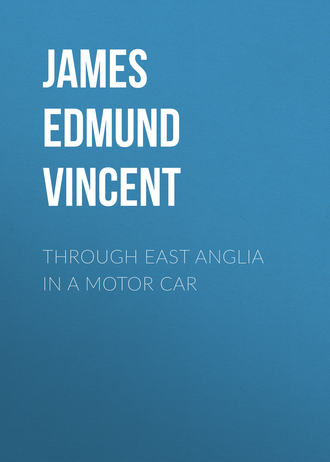 полная версия
полная версияThrough East Anglia in a Motor Car
From Swaffham we make a detour of 4-1/2 miles to Castleacre and to the mystery of earthworks. It is the last place we visit in East Anglia, and, having visited it, it will be just as well to return to the good high road for our return journey to Lynn. What one sees, after a drive across a gorse-clad common, is simple, what it means is another matter. One sees the ruins of the Priory, a great mound, and beyond it a village showing what has become of the ruins of the castle and the Priory. The story of the castle is easily traced with the help of Messrs. Timbs and Gunn. The site was granted by the Conqueror to William de Warrenne; he or his son built a castle, and it remained the property of the family until the fifteenth century. Edward I went there several times as a visitor, but early in the fourteenth century the castle was a ruin. Now we can see only two earthworks, one horseshoe-shaped, the other circular, a faint remnant of the great gateway, and bare traces of foundations of inner parts of the castle. "There is no doubt of the fortress having been erected by the Warrennes, but did they construct the enormous earthworks? Mr. Harrod considers they are not Norman, but Roman, the occupation of the site by the Romans being established, and Roman pottery and coins of Vespasian, Constantine, etc., having been found there. Evidence is then quoted to show that the walls and earthworks were the works of different people, and that the Normans availed themselves of these sites in consequence of their strength. 'And here,' says Mr. Harrod, 'we see the variety of interest afforded by the study of archæology. Here is a castle, of which all interesting architectural features have been destroyed. But probably from that very cause our attention is drawn to the remarkable character of the earthworks, and a view of this subject is presented to our notice, which may hereafter be of great use in the investigation of other remains of a similar kind.'"
"Murray," again, supports Mr. Harrod, adding on his own behalf "the position of Castle Acre, on the line of a very ancient road, known as the 'Peddar's Way,' must always have been one of very great importance." Of this argument we may dispose at once. It has been seen that, if the Peddar's Way was a military road, its importance was due only to the fact that it led to Brancaster, or towards Brancaster; Brancaster was a fortress and watch-tower, seawards against the Saxon pirates, and nothing more. Now let us apply the cold learning and scientific tests of Mr. Haverfield. "The imperfect rectangular earthwork between the church and the ruins of the Saxon and Norman castle has generally been taken to represent a Roman earthen camp of 10 or 12 or (according to others) 22 acres in size, and various finds of Roman objects have been adduced to support the idea. But the camp, so far as I can judge without excavation, is not definitely Roman in character, and hardly any of the objects seem to have been found in or near it." He then goes through the "finds" systematically, and concludes: "I cannot regard this meagre and scattered evidence as adequate to prove the camp Roman, still less to prove it Roman of the first century, as Mr. Fox suggests. It indicates at the utmost a cottage or two, standing perhaps by the Peddar's Way (which runs through Castleacre parish, and earthworks) somewhere about A.D. 300. This may very likely have been to the north of the parish and not in the vicinity of the 'camp.' In truth the best and best authenticated 'find,' an intaglio with an emperor's head, was made two miles north of the 'camp.'"
Where are we then? Merely in a state of knowing that, according to the best authority, there is no adequate evidence for believing the earthworks to be Roman. The problem presented by these earthworks and others is a legitimate subject for conjecture. Dr. Jessopp, in a paper on "The Saxon Burghs of Norfolk," appears to think that Castle Rising, Castleacre, Mileham, Elmham, and Norwich represent a line of Saxon fortresses, some of them occupying sites which were Roman before, erected to resist the Danes in the ninth century. The Roman hypothesis he would probably drop in the light of present knowledge, and, looking at the positions of these places on the map, it is not quite apparent, to say the least of it, why they should have been chosen for points of resistance to invaders from the sea. Were they, then, pre-Roman? That is possible; and it is quite consistent with the absence of Roman remains, for until the Saxon shore became a reality, the Romans had no occasion to fight in East Anglia after they had wiped the Iceni off the face of the earth, and so they had no need for fortresses in it. Or is it just conceivable that here, as has been suggested in the case of Castle Rising, the haughty Norman grandees compelled the subjugated country-folk, by scourge and every brutal method, to pile up these huge mounds?
We can never tell for certain unless the spade be set to work in earnest, perhaps not then even; but in the meanwhile, as we make the run of some twenty miles to Lynn, it is amusing, if somewhat unscientific, to speculate, nor is speculation any the less entertaining in that much of the basis upon which previous theories have rested has been proved to be unsound. Let us, then, think of these mysterious works as we roll home to Lynn; and, having reached it, we have also reached the end.

